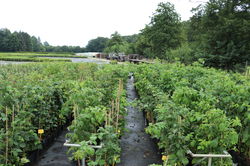 This is true to the motto: "What goes in must come out!" We check the plant authenticity and fruit quality of all larger batches of young plants on a random basis. For this purpose, six randomly chosen young plants from selected young plant batches are potted, cultivated and brought to fruiting. This important “final control” is only one part of our quality assurance.
This is true to the motto: "What goes in must come out!" We check the plant authenticity and fruit quality of all larger batches of young plants on a random basis. For this purpose, six randomly chosen young plants from selected young plant batches are potted, cultivated and brought to fruiting. This important “final control” is only one part of our quality assurance.
The most important elements of quality assurance at Lubera Edibles
In addition to controlling and maintaining the external plant quality of our crop plants, ensuring the internal quality is also crucial, especially regarding the plant propagation. This applies to all plants, but is even more important for fruit-bearing fruit and berry plants, where ultimately it is not the plant but its fruit that makes the difference.
This control and verification of the internal quality basically starts at three points during the production process:
- Intensive screening and testing of the mother plants
- Restriction of subcultures in tissue culture and the reduction of hormone use
- Regular and random checks of the propagated plants for varietal identity, varietal stability and fruit quality
Intensive screening and testing of the mother plants
I have already written about our variety viewing and screening garden in Strullendorf, Germany in a separate article. Here we put the varieties and variety candidates that are propagated by us through their paces and examine their disease resistance and authenticity in order to guarantee that only the very best plant material is used for propagation. The results and findings of the screening and visual checks are now also recorded and documented in the breeding software used by our breeding department. This has the additional benefit that in the future, for older varieties and long sellers, historical data can also be easily accessed and thus any degeneration in fruit quality can be detected and, if necessary, counteracted by an additional selection cycle.
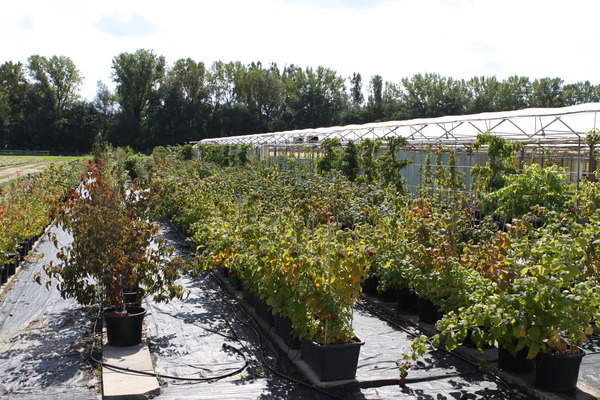
Picture: Variety and True-to-Type testing in Strullendorf (Lubera Edibles GmbH, D)
Restriction of subcultures in tissue culture and the reduction of hormone use
The exponential reproduction of plants possible in tissue culture due to very rapid successive propagation steps reduces the risk of variety confusion (because only a few mother plants are used, which can easily be intensively tested), but also statistically increases the risk of micromutations due to the frequent successive propagation steps. To prevent this, we limit the number of subcultures depending on the crop. In addition, we have significantly reduced the use and dosage of phytohormones over the last 20 years and some crops now manage completely without phytohormones, which also reduces the risk of mutations towards 0.
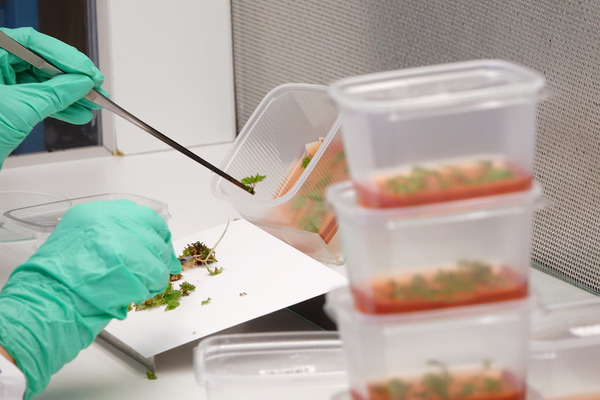
Picture: micropropagation
Regular control of the propagated plants for varietal identity, varietal stability and fruit quality
But does what we put in at the beginning really come out during propagation? Of course we can visually check the young plants produced, just as experienced fruit tree nurseries do with their fruit trees at the end of the growing season. A plant that deviates from the norm visually and, for example, in its autumn colouring, must be examined more closely in any case. But in the end, this is only a rough overview – and in the case of fruit plants, it does not say anything about the real quality of the fruit produced. In addition, we know from our 30 years of experience in tissue culture that such deviations occur very rarely, but that they are often reflected in changes in fruit quality (e.g. so-called “crumbly” raspberries => crumbly raspberry fruit). We have therefore decided to carry out a depth control of the varieties and species that we propagate at regular intervals. For this purpose, up to 160 samples (which correspond to almost 1,000 plants) are taken annually from the propagation batches (often several samples of the same variety, but from different propagation lines, for cross-comparison) and then are put to test.
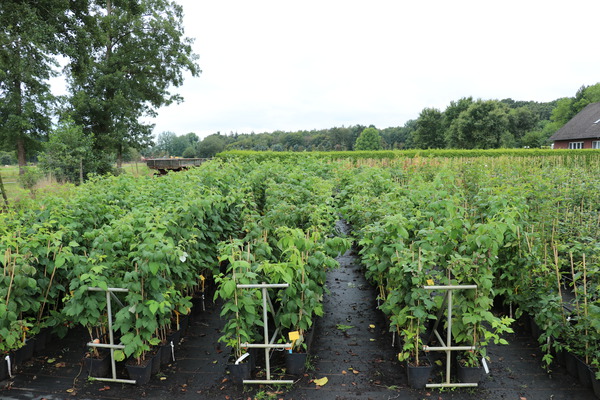
Picture: Raspberries and Blackberries in the follow-up inspection - in 2020 more than 900 plants
Raspberries and blackberries in the follow-up inspection
Our raspberry and blackberry assortment is currently undergoing a follow-up inspection. For this purpose, overwintered young plants were potted directly into 5-litre containers at the end of March and placed in a dripper section of the container area. During the growth phase, a few maintenance procedures (staking and tying) were carried out, but there was no plant protection whatsoever. Also the resulting possible incidence of disease should show us deviations from the variety-typical behaviour under certain circumstances. By the way, these ex post variety tests take place at our sister company Lubera GmbH in Bad Zwischenahn, Germany: this also gives us important information about the regional adaptability of the varieties, which are always at least at three locations:
- The breeding and variety maintenance in Buchs, in the St. Gallen Rhine Valley in Switzerland (Lubera CH)
- The variety screening/mother plant preservation and control in Strullendorf near Bamberg, Germany (Lubera Edibles)
- The quality control for variety-typical growth and fruiting behaviour in Bad Zwischenahn in Lower Saxony, Germany (Lubera DE)
The first inspection can take place at the end of August. Due to the different ripening times of the individual varieties, a further inspection is necessary about four weeks later in order to check all of the varieties that bear fruit on the one-year-old canes. The varieties that fruit on the two-year-old shoots are tied up again; they are overwintered and will bear fruit next year, which we can inspect.
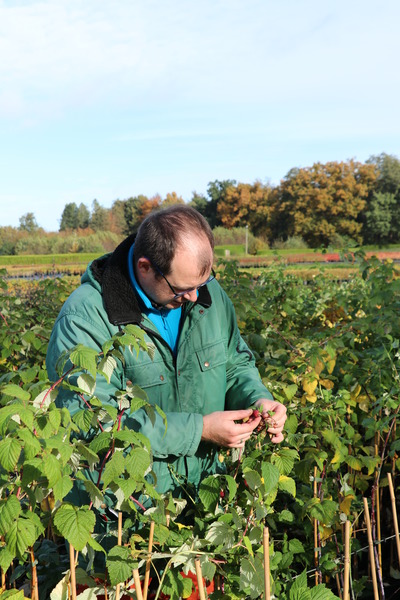
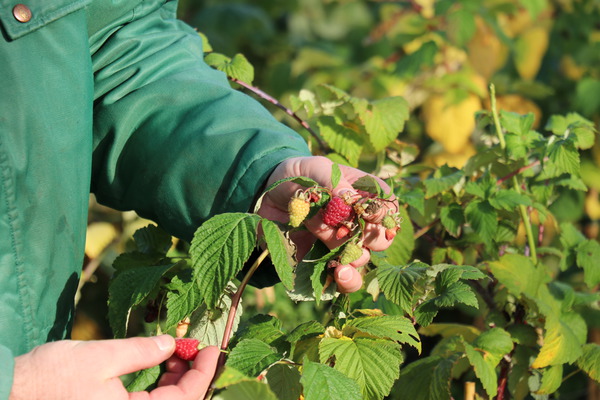
Pictures: Frederik Vollert is doing the fruit evaluation
In total, we can test up to 1,000 plant samples of about 160 varieties/batches per year. Per test unit we produce six plants in 5 L pots.
The quality paradox
By the way, there is an interesting paradox in quality and quality control, of which one should always be aware: the fewer errors you find, the better the quality (and the original quality control). But at the same time, the fewer errors you find, the more meaningless the quality control seems. Errors motivate more quality control. The best quality (where no errors or defects are found) undermines the motivation for quality control...Of course we are not immune to such doubts and considerations: does it really make sense to go to all the trouble when almost no errors are found? On the other hand, however, one must always be aware of the great effects that a small deviation in fruit quality, for example, can have if it is not recognised over the years and is not corrected by selection, but is instead propagated 100,000-fold and at best intensified.
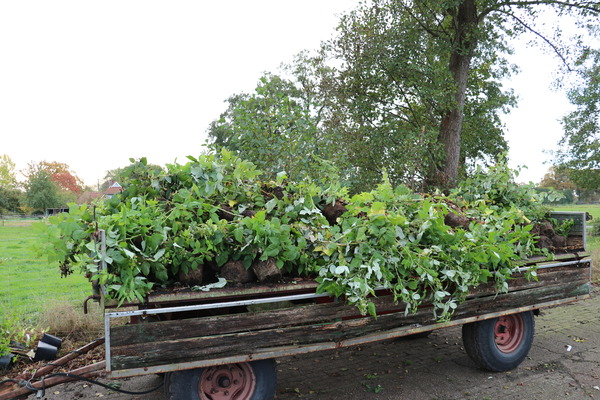
Picture: all raspberries that have fruited in the same year are disposed of after the valuation has been completed
And how many “defects” can be found?
First of all, there is (in addition to the possible detection of errors or defects) also a positive result of these controls: due to the cultivation and intensive control we also produce new mother plants, which we can feed back to the beginning of the quality assurance system if necessary. Negatively conspicuous plant samples are extremely rare, but they do exist, of course: this year, we came across extremely late fruiting in a newer breeding (not from our own programme, by the way), which we have to check further. And with an older variety we have observed an accumulation of untypical fruits. This will lead immediately to the need to make new starting crops of checked mother plants next spring. We will also observe the variety more closely at all three locations, and in the worst case, we will also stop propagation.
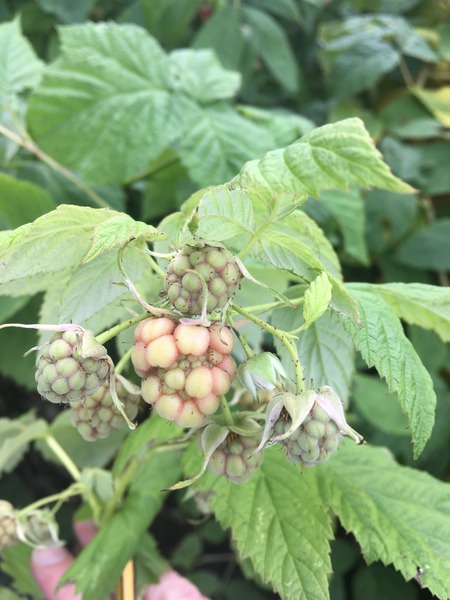
Picture: clearly visible the significantly deformed raspberry fruits
How good can plant propagation quality assurance be?
Are we now becoming quality fetishists at Lubera Edibles? Are we now starting to send our employees to courses with the automotive industry, which boasts of (almost) no more mistakes? (Well, except for the known gap dimensions in my BMW that led water to the navigation system and the safety box...)
We are aware that quality assurance for plants in general and for fruit-bearing plants in particular can never be complete and it cannot even achieve the reliability of the (apparently quite imperfect) processes in the automotive industry. The reason for this is quite simple: a screw and even a car door is essentially a sum of the processes of its manufacture. If these processes are controlled and reliable, a reasonable result can be expected. The only weak point that remains is the human being, who is a rather imperfect living being. The plant itself is a living being, and the quality of the plant is not only the sum of the plant propagation processes. Plants are influenced by environmental conditions and care measures. And they can also change themselves (quite randomly) due to larger or smaller mutations. Even with the best quality control we will not be able to avoid this problem. But that's why we produce young plants – and not screws.
